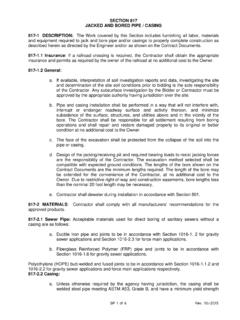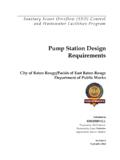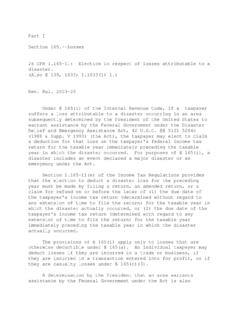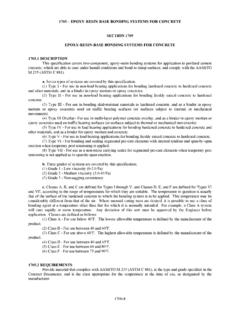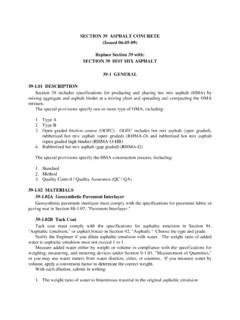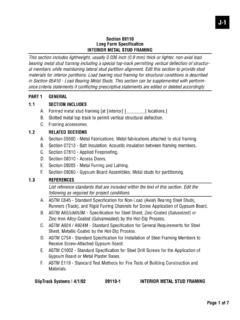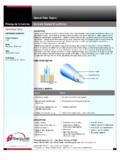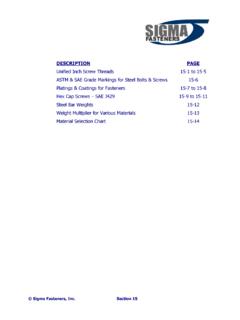Transcription of SECTION 819 MICROTUNNELING AND PIPE …
1 SECTION 819. MICROTUNNELING AND pipe - jacked TUNNELS. 819- 1 description : This Work consists of all materials, labor and equipment required to directly install product pipelines typically 24 and larger, underground in a single pass using an appropriate tunnel boring machine combined with pipe -jacking techniques. This specification also covers Pilot Tube MICROTUNNELING (PTMT). Pilot Tube MICROTUNNELING shall be defined as an alternate MICROTUNNELING system typically for sizes 6" through 27" inner diameter. This system is a two or three stage system, which allows both trenchless guided installation of house connection sewers as well as accurate direct jacking of smaller diameter pipelines without use of casing. Scope of Work: a. Construction of tunnels by one-pass methods with or without man entry. The construction methods involve jacking pipe following a hand-shield excavation or a tunnel boring machine (TBM) or micro- tunnel boring machine (MTBM), with the pipe serving as both the tunnel liner during construction and the sewer pipe after completion of construction.
2 B. Construction of smaller diameter pipelines utilizing the Pilot Tube MICROTUNNELING process. The system shall utilize a two or three phase system. c. The Contractor may select pipe materials as listed in the QPL for MICROTUNNELING and pipe - jacked Tunnels, or approved equal. d. Ancillary work includes mix design requirements, testing, furnishing and production of grout for: 1. Pressure grouting of bolted liner plates for shafts. 2. Pressure grouting of primary tunnel liner. 3. Pressure grouting of jacked - pipe . 4. Annular grouting uncased sewer pipe . 5. Grouting voids in ground resulting from caving, loss of ground, or settlement. 6. Grouting of manholes constructed in shafts. 7. Compaction grouting is not part of this specification. e. Construction, maintenance, and backfilling of tunnel shafts. Definition: a. jacked pipe : A method for installing sewer pipe that serves as initial construction lining and tunnel support, installed for stability and safety during construction, and as the sewer pipe .
3 The pipe is shoved forward, or jacked , as the tunnel is advanced. b. MICROTUNNELING : A method of installing pipe by jacking the pipe behind a microtunnel boring machine which is connected to and shoved forward by the pipe being installed, generally precluding man entry. c. Pilot Tube MICROTUNNELING (PTMT): Multi stage method of accurately installing a product pipe to line and grade by use of a guided pilot tube and followed by upsizing to install the product pipe . The system must use a guidance system to insure accuracy, is remotely operated and does not require man entry to the tunnel for normal operations. The guidance system, consisting of target, theodolite, camera, and monitor, can detect the deviation of the drilling profile, and gives the operator SP 1 of 22 Rev. 10/2015. continuous information about the location of the steering head. d. tunnel Boring Machine (TBM): Mechanized excavating equipment that is steerable, guided and articulated, connected to and shoved forward by the pipe being installed, with man entry.
4 E. Microtunnel Boring Machine (MTBM): Mechanized excavating equipment that is remotely-controlled, steerable, guided and articulated, connected to and shoved forward by the pipe being installed, usually precluding man entry. f. Tunneling Methodology: A written description, together with supporting documentation that defines Contractor's plans and procedures for the MICROTUNNELING or pipe jacking operations. g. Zone of Active Excavation: Area located within a radial distance about a surface point immediately above the face of excavation equal to the depth to the bottom of the excavation. h. Critical Structure: Any building, structure, pipeline, utility, bridge, pier, or similar construction partially or entirely located within a zone of active excavation. i. Pressure Grouting: Filling a void behind a liner or pipe with grout under pressure sufficient to ensure void is properly filled but without overstressing temporary or permanent ground support, or causing ground heave to occur.
5 J. Back Grouting: Secondary pressure grouting to ensure that voids have been filled between shaft liners and the surrounding ground. k. Annular Grouting: Filling the annular space between the carrier pipe and the ground, by pumping. l. Ground Stabilization Grouting: The filling of voids, fissures, or under- slab settlement due to caving or loss of ground by injecting grout under gravity or pressure to fill the void. Qualifications: a. Tunneling and MICROTUNNELING Contractors will have actively engaged in the installation of pipe using tunneling and MICROTUNNELING for a minimum of three years, during which time the Contractor will have completed at least 15,000 linear feet of MICROTUNNELING installations. b. Field supervisory personnel employed by the Tunneling or MICROTUNNELING Contractor will have at least two years of experience in the performance of the work and tasks as stated in the Contract Documents. Submittals: a. Qualifications: Submit documentation showing that the Contractor and personnel meet the minimum required qualifications stated in SECTION Include a list of a minimum of three wastewater collection projects similar in scope and value to the project specified in the contract documents.
6 Information must include, but not be limited to date and duration of work, location, pipe information ( length, diameter, depth of installation, pipe material, etc.), project owner information ( name, address, telephone number, contact person), and the contents handled by the pipeline (water, wastewater, etc.). SP 2 of 22 Rev. 10/2015. b. Materials: 1. Submit pipe material reference sheets and manufacturer's certification of pipe meeting or exceeding the required specifications. 2. Submit a description of materials, grout mix, equipment and operational procedures to accomplish each grouting operation. The description may include sketches as appropriate, indicating type and location of mixing equipment, pumps, injection points, venting method, flowlines, pressure measurement, volume measurement, grouting sequence, scheule, and stage volumes. i. Submit a grout mix design report, including: A. Grout type and designation. B. Grout mix constituents and proportions, including materials by weight and volume.
7 C. Grout densities and viscosities, including wet density at point of placement. D. Initial set time of grout. E. Bleeding, shrinkage/expansion. F. Compressive strength. ii. For cellular grout, also submit the following: A. Foam concentrate supplier's certification of the dilution ratio for the foam concentrate. B. A description of the proposed cellular grout production procedures. iii. Maintain and submit logs of grouting operations indicating pressure, density, and volume for each grout placement. c. Tunneling Methodology: A brief description of proposed tunnel methodology for review. The description should be sufficient to convey the following: 1. Proposed method of tunnel construction and type of face support. 2. Manufacturer and type of tunneling equipment proposed. Describe type of lighting and ventilation systems. 3. Number and duration of shifts planned to be worked each day. 4. Sequence of operations. 5. Locations of access shafts and work sites. Describe method of construction for tunnel shafts.
8 6. Method of spoil transportation from the face, surface storage and disposal location. 7. Capacity of jacking equipment and type of cushioning. 8. Identify critical utility crossings and special precautions proposed. 9. Slurry injection system details. SP 3 of 22 Rev. 10/2015. d. tunnel Shaft Schedule of Values: Cost per shaft by station, diameter, and depth. e. tunnel Shafts: Submit shaft construction drawings together with calculations. As a minimum the submittal shall include: 1. Shaft dimensions, design criteria, and details for ground support system, such as sheeting, shoring, bracing, and stabilization, protection of the excavation, special requirements for shaft penetrations, tunnel "eye", starter and back tunnels, and seal slabs. Allowable surcharge loads and any restrictions on surcharge capacity, including live loads, shall be clearly shown on the shaft construction drawings. Thrust blocks or other reactions required for pipe jacking shall be shown, if applicable. 2.
9 Location of shafts by station and limits of working sites. 3. Description of site security arrangements in conformance with Subsection 4. Description of method of extending the shaft above the flood level in compliance with Subsection 5. Any geotechnical / boring undertaken by the Contractor for whatever purpose connected to the Work. 6. Submit shaft temporary deck drawings and calculations in the event that a shaft is not needed for immediate construction activity, in conformance with Subsection 7. Shaft design submittals by the Contractor shall be signed and sealed by a Professional Engineer registered in the State of Louisiana. f. Drawings and Calculations: Submit for record purposes, drawings, and calculations for any tunnel support system designed by the Contractor. Drawings shall be adequate for construction, and include installation details. For pipe jacking and MICROTUNNELING show pipe and pipe joint detail. Documents must be signed and sealed by a Professional Engineer registered in the State of Louisiana.
10 Calculations shall include clear statement of criteria used for the design as described in Subsection Engineer's review of all drawings and calculations is for information purposes and overall compliance. g. Quality Control: Submit for review a brief description of quality control methods including: 1. Method and frequency of survey control. 2. Example of tunnel daily log. h. Geotechnical Investigation: When geotechnical investigations are conducted by the Contractor, submit results in both hardcopy and electronic form to the Engineer for record purposes. i. Monitoring Plans: The Contractor shall provide monitoring plans per Subsection for assessing ground movement (settlement or heave) due to drilling operations as follows: SP 4 of 22 Rev. 10/2015. 1. Instrumentation Monitoring Plan: Submit for review, prior to construction, a monitoring plan that includes a schedule of instrumentation design, layout of instrumentation points, equipment installation details, manufacturer's catalog literature, and monitoring report forms.
